Understanding Bletchley Park: Cracking the Enigma Code and Beyond

We may earn a small fee from the companies mentioned in this post.
The secret world of Bletchley Park is one of the most fascinating chapters in the history of World War II. It was here that a group of brilliant minds, including the renowned mathematician Alan Turing, cracked the infamous Enigma code, helping to shorten the war and save countless lives.
In this blog post, we’ll delve into the history of Bletchley Park, the people who worked there, and the legacy they left behind in the fields of computing and cryptography. Follow us on this journey through time and discover the extraordinary stories that unfolded behind the gates of this top-secret facility, known as Bletchly Park.
Key Takeaways – Understanding Bletchley Park
Bletchley Park was a historically significant site during World War II, responsible for the decryption of Enigma machines and successful execution of key military operations.
Alan Turing’s development of the Bombe machine and codebreaking technique were instrumental in cracking the Enigma Code, aiding Allied forces in WWII.
The Bletchley Park Trust works to preserve its legacy while The National Museum of Computing offers interactive exhibits on computing technology history.
Bletchley Park: A Historical Overview
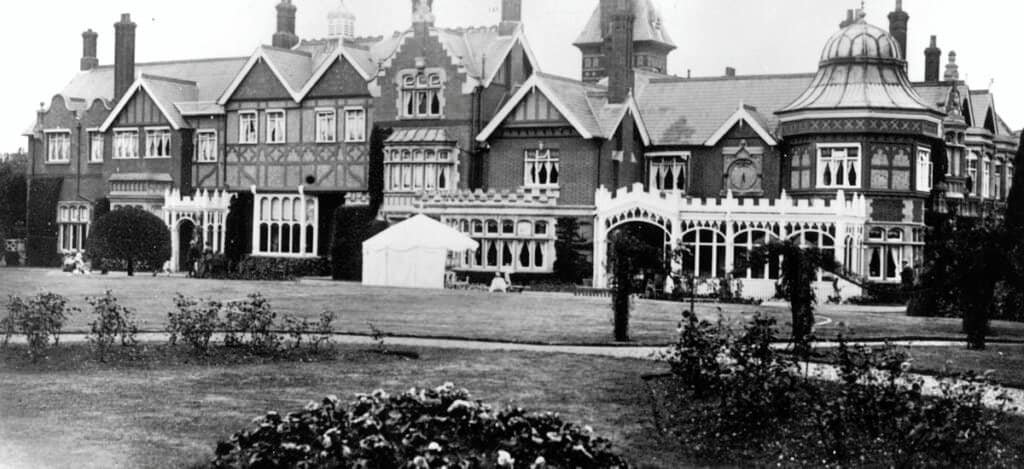
Bletchley Park, the heart of British codebreaking operations during World War II, occupies a unique spot in history. The intelligence gains made at Bletchley Park, such as the decryption of Enigma machines, had a profound impact on the course of the war.
The significance of the work undertaken here cannot be overstated, as it was instrumental in the successful execution of Operation Husky (invasion of Sicily) and other major military operations.
Around 9,000 individuals were engaged at the height of Bletchley Park’s operations, relentlessly devising code-breaking machines and decoding enemy communication.
The Birth of Bletchley Park
Bletchley Park:
Established in 1883
Became the wartime home of the British Government Code and Cypher School in 1939
Initial focus was on decrypting Enigma-generated messages, which proved to be a turning point in the war
Bletchley Park’s pivotal role during the war, especially the intelligence amassed, greatly influenced the Allied victory.
Wartime Operations and Successes
During the second world war however, Bletchley Park buzzed with action, concentrating primarily on deciphering Enigma and other ciphers. The codebreaking efforts at Bletchley Park were led by a remarkable group of individuals, including:
Alan Turing
Gordon Welchman
Hugh Alexander
Bill Tutte
Stuart Milner-Barry
The work carried out at Bletchley Park was so significant that the official historian of British intelligence has stated that the “Ultra” intelligence produced there was instrumental in shortening the war by two to four years, and without it, the outcome of the war would have been uncertain.
The German military, also known as the German armed forces, used Enigma, an encoding machine, for secure communication through encrypted German messages. To crack the Enigma code, Turing and Welchman developed the Bombe machine, an electro-mechanical decryption device, that was instrumental in deciphering Enigma-machine-encrypted secret messages during World War II.
The enigma decrypts process, enabled by the Bombes, was a critical intelligence asset for the Allies, allowing them to gain a strategic advantage against Nazi Germany during the conflict.
The use of mathematical logic and analysis played a pivotal role in deciphering the Enigma code. As a result, Bletchley Park’s codebreaking efforts had a profound impact on the war, enabling the Allies to gain crucial intelligence and ultimately secure victory.
Alan Turing: The Man Behind the Machine

Alan Turing was an extraordinary mathematician, computer scientist, and logician who made groundbreaking contributions to the fields of mathematics, cryptanalysis, and computer science. His work at Bletchley Park during World War II was a testament to his genius, as he played a pivotal role in cracking the Enigma code and developing early computing concepts.
Turing’s work during and post-war has had a lasting impact on computer science.
Turing’s Early Life and Career
Born in London in 1912, Alan Turing pursued mathematics at Cambridge University. After graduating, he continued his studies at Princeton University in the United States. It was during his time at Princeton that Turing developed the concept of the Universal Turing Machine, a hypothetical computing device that laid the groundwork for modern computing.
When World War II broke out, Turing was recruited to work at Bletchley Park, where he played a key role in the development of code-breaking machines, including the Bombe and the Colossus. His work in breaking the Enigma code and other encrypted messages was instrumental in the Allied victory.
Cracking the Enigma Code
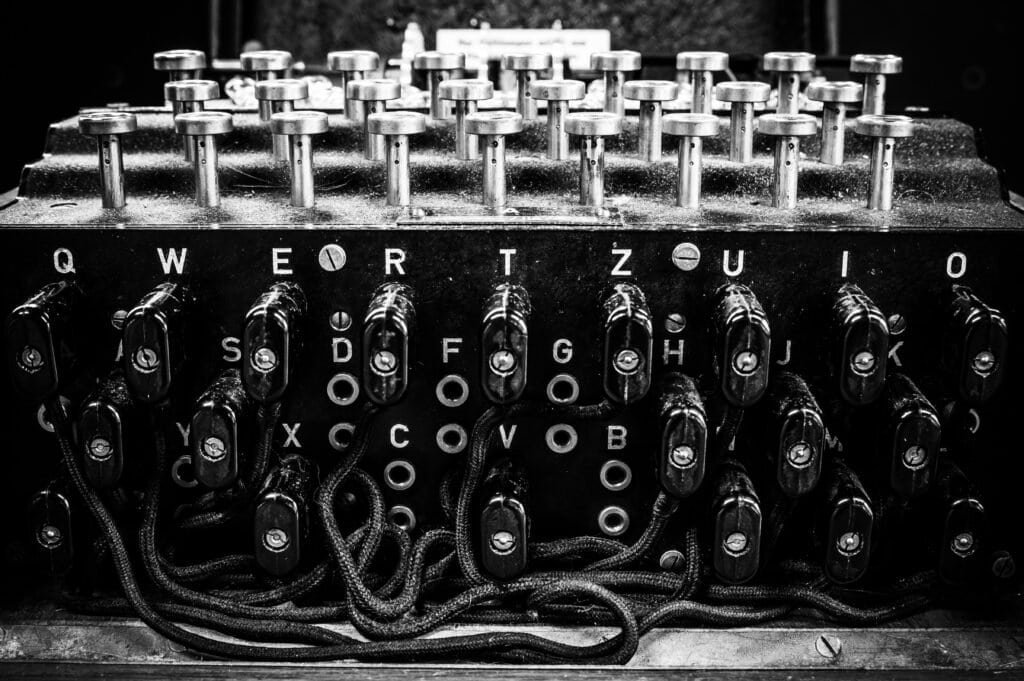
Turing’s work on the Enigma code was nothing short of groundbreaking. He devised a complex code-breaking technique called “Turingery” and developed the Bombe machine in collaboration with Gordon Welchman. The Bombe machine was designed for a specific purpose.
It was used to elucidate the daily key, wheel order, plugboard settings, wheel settings and plugboard configuration required to decipher the Enigma messages intercepted every day..
Turing’s method for breaking the Enigma code relied on the use of “cribs” – comparing patterns of the encrypted message and known portions of plaintext, such as weather updates – to break the key.
The Bombe machine was an electro-mechanical device that effectively ran all 159 quintillion combinations to determine the correct setting. Turing’s efforts to crack the Enigma code were so successful that his work is credited with shortening the war and saving countless lives.
In December 1942, Turing travelled to the United States to share his expertise on Enigma and the Bombe machines with US military intelligence. His collaboration with the American codebreakers further strengthened the Allies’ ability to decipher encrypted messages and gain valuable intelligence on enemy operations.
Post-War Legacy and Recognition
Despite his untimely death, Alan Turing’s legacy continues to shape the world of computer science and cryptography. His contribution to deciphering the Enigma code during World War II significantly influenced the Allied victory.
Moreover, his concept of the Turing machine laid the groundwork for contemporary computing. In recognition of his contributions, Turing was posthumously awarded the Order of the British Empire and is widely regarded as the father of modern computer science.
However, Turing’s life was not without challenges. He faced persecution for his homosexuality, which ultimately led to his tragic death. Today, his story serves as a reminder of the extraordinary accomplishments of an individual who overcame adversity to change the course of history.
You may find our informative article on Room 40 the Admiralty interesting
The Women of Bletchley Park
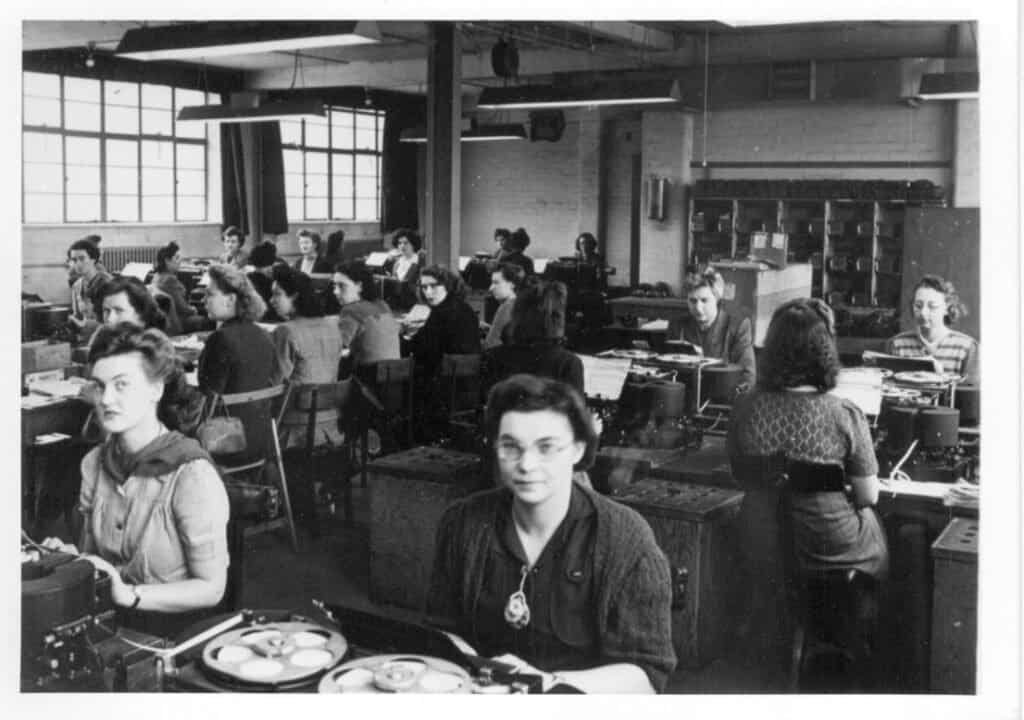
While Alan Turing’s contributions to Bletchley Park are well-known, the vital roles played by the women working at the site are often overlooked. These remarkable women, such as:
Joyce Aylard
Pamela Rose
Pat Davies
Charlotte Webb
Joan Clarke
Margaret Betts
These extraodinary woman made significant contributions to the codebreaking efforts and daily operations of the Park.
The commitment and proficiency of these women significantly influenced the success of Bletchley Park’s mission.
The Female Codebreakers
The female codebreakers of Bletchley Park assumed various roles, including:
Administrators
Index card compilers
Dispatch riders
Code-breaking specialists
Their work was crucial in cracking the Enigma code, as well as other enigma codes, ultimately contributing to the Allied victory in World War II.
Some of the most renowned female codebreakers include:
Joan Clarke
Joan Clarke, a brilliant cryptanalyst, carved her place in history through her invaluable contributions at Bletchley Park during World War II. A Cambridge mathematics graduate, Joan entered the secretive realms of Bletchley in 1940, immersing herself in the intricate task of deciphering messages encrypted by Nazi Germany’s Enigma machine.
In the hushed halls of Hut 8, Joan collaborated closely with the renowned Alan Turing. Together, they navigated the labyrinth of naval Enigma codes, playing a pivotal role in the Allies’ success in the Battle of the Atlantic. Clarke’s analytical acumen and relentless dedication distinguished her amidst the turmoil of war, even as she navigated the gender biases prevalent in a male-dominated field.
Joan’s journey was marked not just by her cryptographic triumphs, but also by personal bonds, notably a brief engagement to Turing, which dissolved due to Turing’s homosexuality. Their mutual respect and friendship, however, endured beyond the vicissitudes of their personal lives.
Pamela Rose
Pamela Rose, a linguist and musician, joined the hushed cadence of Bletchley Park’s codebreaking ensemble during World War II. With a mind adept at deciphering patterns, Pamela turned the encrypted messages of the Axis powers into revelations, aiding the Allies’ strategic maneuvers. Amidst the shadows of secrecy, her role in the Government Code and Cypher School became a critical act in the silent play of wartime cryptography.
The war etched a narrative of camaraderie and unvoiced achievements in Pamela’s life, with friendships forged in the crucible of conflict. In the post-war period, Pamela’s contributions remained a muted symphony, gaining recognition only in the latter crescendo of history’s unfolding. Her life resonated with the melodies of music and education, but her silent bars at Bletchley Park compose an everlasting echo in the annals of codebreaking valor.
Charlotte Webb
Charlotte Webb’s story is a hidden treasure in the illustrious tapestry of Bletchley Park’s history. A brilliant mind amid the secrecy-shrouded corridors of wartime codebreaking, Charlotte navigated the labyrinth of encrypted communications with unwavering dedication and exceptional analytical prowess.
Faced with the societal norms of her era, her contributions were made in silence, echoing the unsung efforts of numerous women whose intellectual labour laid the foundations of Allied success during World War II.
Charlotte’s legacy, though subtly etched into the pages of history, exemplifies the remarkable, yet often unnoticed, achievements of the silent heroines of Bletchley Park, remaining a testament to resilience, talent, and quiet triumph in the shadows of a global conflict.
Jane Fawcett
Jane Fawcett, a remarkable codebreaker at Bletchley Park, etched her legacy in the clandestine chronicles of World War II. Initially an aspiring opera singer, Jane’s path veered into the intense theatre of cryptanalysis, where she became an unsung heroine among the assembly of extraordinary women who relentlessly worked to unveil the secrets of the enemy.
A momentous highlight of Jane’s contributions came when she accurately deciphered the critical coordinates of the formidable German battleship, Bismarck. Her keen analysis was instrumental in the Allies’ strategic triumph, enabling the Royal Navy to sink the battleship and alter the course of the naval war.
Jane Fawcett’s tale is emblematic of the silent yet significant contributions of the women at Bletchley Park, illustrating a narrative of patriotic dedication, intellectual brilliance, and the quiet resolve that played a pivotal role in shaping the outcomes of World War II.
Their stories highlight the importance of women’s contributions to the war effort and the vital roles they played in the success of Bletchley Park’s mission.
Support Services and Daily Life
In addition to their work as codebreakers, women at Bletchley Park also played important roles in support services. They were provided with assistance from organizations such as the Auxiliary Territorial Service (ATS) and the Women’s Royal Naval Service (WRNS), which offered administrative and logistical support.
The female codebreakers also had access to resources such as libraries, typists, and other codebreakers, who collaborated in order to decipher complex codes.
Daily life for the women at Bletchley Park included living accommodations, dining facilities, and recreational activities to support their well-being and productivity. The camaraderie and teamwork among the women working at the site contributed to the success of their mission and the overall accomplishments of Bletchley Park during the war.
Preserving Bletchley Park’s Legacy
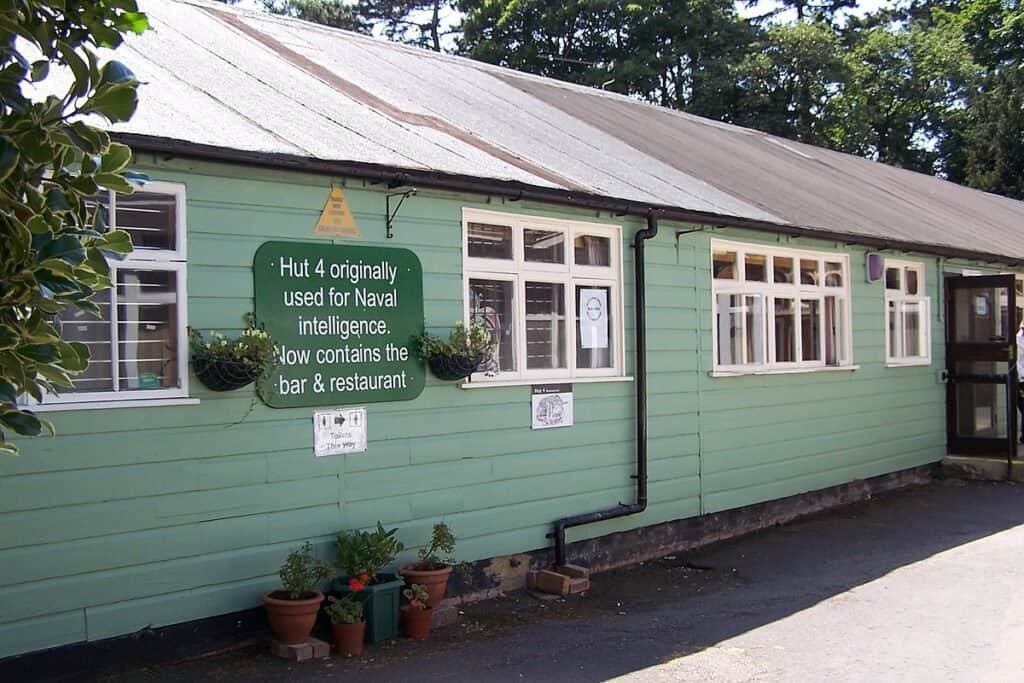
Preserving Bletchley Park’s legacy, a vital chapter of British history, is of tremendous importance. It serves as a reminder of the remarkable accomplishments of those who worked there during World War II and the crucial role they played in the war effort.
The Bletchley Park Trust was established in 1992 to preserve and share the site’s history, ensuring that future generations can learn from and appreciate this unique part of our past.
The Bletchley Park Trust
Founded in February 1992, the Bletchley Park Trust aimed to protect significant areas of the site from possible development.
Their mission is to engage, inspire, and educate people from all over the world with Bletchley Park’s past and accomplishments. In order to achieve this goal, the Trust has undertaken efforts to restore the site, establish a museum, and facilitate educational events and activities.
The Trust’s work ensures that the legacy of Bletchley Park and the stories of the individuals who worked there are preserved for future generations. The annual Bletchley Park Veterans’ Reunion is just one example of the Trust’s efforts to honor and remember those who served at the site during World War II.
Visiting Bletchley Park Today
Today, Bletchley Park offers visitors:
A vibrant heritage attraction featuring immersive films, interactive displays, and hands-on activities
The opportunity to explore the collections, discover surprising stories, and appreciate the beautiful grounds
A variety of events throughout the year, such as live music, talks, and children’s activities
An engaging and educational experience
It is recommended that visitors allocate four to five hours for a visit, to fully immerse themselves in the fascinating history of this unique location.
Bletchley Park’s legacy is preserved and shared through the work of the Bletchley Park Trust, ensuring that future generations can learn from and appreciate the extraordinary accomplishments of those who worked there during the war.
Visiting Bletchley Park today provides an unparalleled opportunity to delve into the world of codebreaking and experience the history of this remarkable site firsthand.
The National Museum of Computing
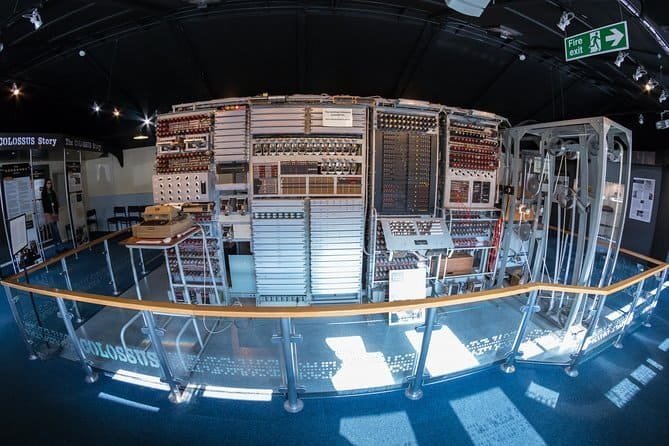
Situated at Bletchley Park, The National Museum of Computing serves as a rich resource for those intrigued by the history of computing and codebreaking technology.
The museum houses the world’s largest collection of functioning historic computers, providing a comprehensive overview of the progression of computing from its early days to contemporary technology.
The museum also facilitates lectures, workshops, exhibitions, and educational programmes for students and adults, making it an engaging and informative destination for all who visit.
The Turing-Welchman Bombe
One of the most notable exhibits at The National Museum of Computing is The Turing-Welchman Bombe. This electro-mechanical device was used to decode Enigma-enciphered messages during World War II. The first Bombe itself was developed by Alan Turing and Gordon Welchman, and its reconstruction is on display at the museum for visitors to see and appreciate.
The Bombe, an extraordinary invention that manifested at Bletchley Park during World War II, marked a pivotal advancement in the cryptanalytical battles of the era. Conceived by the brilliant mind of Turing and Welchman, it was enhanced by the ingenuity of the codebreakers at Bletchely. The Bombe emerged as a mechanical prodigy designed to combat the complexities of the German Enigma machine.
Turing’s vision, fueled by a profound understanding of cryptography and mathematical logic, materialised into the Bombe—a device that automated the decryption process, exponentially accelerating the codebreakers’ efforts. Through a symphony of whirring rotors and electrical circuits, the Bombe undertook the Herculean task of sifting through a multitude of possible Enigma settings, seeking the elusive configurations that would unveil the secrets encoded within intercepted messages.
Collaborative brilliance shone through in the development and refinement of the Bombe. Engineers and technicians, such as Harold Keen, played instrumental roles in bringing Turing’s conceptual masterpiece to functional reality, optimising its mechanisms and ensuring its operational efficacy.
The Bombe’s impact resonated profoundly within the concealed chambers of Bletchley Park and across the theatres of war. It became an indispensable ally in the codebreakers’ quest, enabling them to unravel the intricate cryptograms of conflict, and consequently facilitating strategic successes that hastened the conclusion of the global conflagration.
Other Exhibits and Collections
In addition to the Turing-Welchman Bombe, the National Museum of Computing features a wide range of exhibits and collections, showcasing the evolution of computing technology over the years.
One notable exhibit is the Colossus computer, a reconstructed version of the world’s first electronic computer used to decipher the German Enigma code during World War II.
Another fascinating display is the Microsoft Timeline collection, which chronicles the development of computing from its beginnings to current technology.
Visitors can explore the museum’s exhibitions and collections on their website or in person, providing an engaging and informative experience for all who are interested in the history and development of computing technology.
Summary
Bletchley Park’s extraordinary history and the individuals who worked there, such as Alan Turing and the female codebreakers, played a pivotal role in the Allied victory during World War II.
Today, their legacy is preserved and shared through the efforts of the Bletchley Park Trust, the National Museum of Computing, and the various exhibits and events that bring this fascinating period of history to life.
By exploring and learning about Bletchley Park, we can better understand the importance of innovation, dedication, and teamwork in overcoming adversity and shaping the world we live in today.
Frequently Asked Questions
Can you see the Enigma machine at Bletchley Park?
Yes, visitors of Bletchley Park can view the Enigma D machine, which is the earliest model on display and more sophisticated than the original design developed in 1926.
How long does it take to go around Bletchley Park?
To get the most out of Bletchley Park, allow four to five hours for a visit. The tickets purchased are Annual Passes so you can return as often as desired within a year.
How much does it cost to go to Bletchley Park?
Visiting Bletchley Park costs from £15 per adult, depending on the type of ticket and any discounts applied.
Was Alan Turing at Bletchley Park?
Yes, Alan Turing worked at Bletchley Park as part of a team in Hut 8 to break the Naval Enigma.
What is the meaning of code breaking?
Code breaking is the process of decrypting code or cipher messages without proper authorisation. It typically involves unauthorised persons attempting to access sensitive data.
Who broke the Enigma code at Bletchley Park?
Alan Turing and his team broke the Enigma code at Bletchley Park.
When did Bletchley Park break Enigma?
Bletchley Park broke Enigma during World War II, starting in 1939.
Useful External Reference Sites
1. Bletchley Park Official Website
- URL: Bletchley Park
- Description: The official website offers a wealth of information including visitor details, historical insights, and details on exhibitions and events.
2. The National Museum of Computing
- URL: The National Museum of Computing
- Description: Located at Bletchley Park, the museum’s website includes information on wartime codebreaking machines.
3. BBC History
- URL: BBC History
- Description: Search for articles related to Bletchley Park and its significant historical contributions.
4. Imperial War Museums
- URL: Imperial War Museums
- Description: Find collections and stories related to the codebreakers of Bletchley Park.
5. The National Archives
- URL: The National Archives
- Description: Discover official government records and documents related to Bletchley Park.
6. History Extra
- URL: History Extra
- Description: Find articles and podcasts that dive into the history of Bletchley Park’s codebreakers.
7. The Guardian – Bletchley Park Collection
- URL: The Guardian
- Description: The Guardian’s website includes a collection of articles related to Bletchley Park.
8. GCHQ (Government Communications Headquarters)
- URL: GCHQ
- Description: Find historical insights into cryptography and the legacy of Bletchley Park.
9. The British Library
- URL: The British Library
- Description: Explore resources that discuss the historical context and significance of Bletchley Park.
With over three decades of experience in the heart of London’s financial sector, I have dedicated my career to the pursuit of robust cybersecurity practices and IT leadership. As a Certified Information Systems Security Professional (CISSP), Certified Information Security Manager (CISM), Certified Chief Information Security Officer (C|CISO), Certified Ethical Hacker (CEH), and Computer Hacking Forensic Investigator (CHFI), I bring a wealth of knowledge and expertise to the table.
My journey in the field of cybersecurity has not only been about personal growth but also about sharing my insights with others. As an international speaker, I have had the privilege of addressing audiences worldwide, discussing the importance of cybersecurity in today’s digital age. My passion for knowledge sharing extends to my work as an author and blogger, where I delve into the complexities of cybersecurity, offering practical advice and thought leadership.
In my role as a CISO and Head of IT, I have overseen the development and implementation of comprehensive information security and IT strategies. My focus has always been on creating resilient systems capable of withstanding the evolving landscape of cyber threats.
My Master’s degree in Cybersecurity has provided a solid academic foundation, which, when combined with my practical experience, allows me to approach cybersecurity from a holistic perspective.
I am always open to connecting with other professionals in the field, sharing knowledge, and exploring new opportunities. Let’s secure the digital world together.

